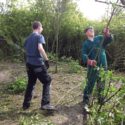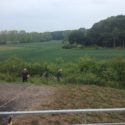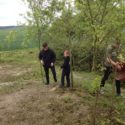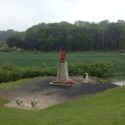Wasn`t it Winston Churchill who first spoke in terms of “the end of the beginning ?”.
The Lochnagar Crater lies only a few hundred metres from the Albert to Baupamme Road which served as the axis of advance for the First World War`s Somme Offensive. It was created by a massive underground detonation which heralded the start of the attack on the morning of the 1st July 1916.
The Crater is now in private hands but is open to the public, for the pursuance of “peace, fellowship and reconciliation”, at no cost. Rossett Platoon, Clwyd and Gwynedd Army Cadet Force were first asked to help with clearing the undergrowth around the Crater perimeter in 2009. With dogged perseverance the Cadets have returned year on year to contend with the dense, predominantly hawthorn, vegetation.
In 2012 the custodians of the Mametz Memorial, to the casualties from the 38th (Welsh) Division who fought through Mametz Wood in mid July 2016, recognising the good work of the Cadets, requested that they clear the area to the front of the Memorial. As with the Crater the problem being overgrown hawthorn.
On 23 May 2014, again generously supported by the Ulysses Trust, 8 Cadets from Rossett Platoon with their usual adult support, embarked on Ex Lochnagar Dragon III. Their mission to complete the clearance of the Crater`s perimeter and to continue their work at the Mametz Memorial.
Of course if you are to take the trouble of digging beneath enemy lines, removing the chalk spoil so as not to alert aerial reconnaissance and planting 60 tons of high explosive in two chambers 80 feet underground you have to have good reason. The reason, naturally, was to compromise the high ground from where the British infantry, coming over the top and through the wire defences, would be particularly vulnerable. The topography that makes a commanding defensive position quite inevitably makes an ideal peacetime viewpoint from which to survey the surrounding area.
In 2009 a visitor to the Crater walking it`s perimeter would, looking outwards, see nothing more than a hawthorn wall. Five years later the first phase is complete. Due to the hard work of the Cadets the several hundred thousand visitors to the Crater, in the next four 100th anniversary years, will be able to look from the Crater`s edge out towards the Basilica of Notre Dame de Brebieres church in Albert, the Tara and Usna hillsides from where the British troops relieved on the morning of 1st July 1916 watched the battle unfold, the lines along which the British and German trenches extended and the village of La Boiselle. The transformation is spectacular and the Cadets will now look to find some way of commissioning an aerial photograph, the only viable way of recording the extent of their excellent work.
The initial phase of the Somme Offensive gained a little ground and the Germans were pushed from the high ground back into Mametz Wood. The woods face a gentle incline down which the Welsh Division advanced. The Memorial is set on a small platform cut into this gentle bank. A Red Dragon, defiantly clutching barbed wire, set on a stone plinth faces the wood. In 2012 the view from the Memorial to the woods was totally obscured. The hard work of the Cadets has ensured the Dragon now looks out on to the full vista of the Mametz Wood battlefield. A lady visiting the Somme from Essex was moved to comment that the labour of the Cadets, representatives of the often vilified younger generation, had “gladdened her heart”
Ranging from Cadet RSM Cieran Edwards, on his 7th visit to the Somme with his Platoon, to Cadet Dominik Zelinski, who the Platoon assisted with his passport application, to Cadet Daniel Morris, on his first significant time away from home with the ACF the Cadets now settle into the work routine with consummate ease. Such is their appetite for the task that they started work on the Saturday afternoon after having driven through Friday night. Intermittent rain, sleeping under canvas and the daily march to location doing nothing to dent their enthusiasm. They are to be congratulated on a job very well done.
As for the beginning of the end ? Mother Nature has no concept of, or respect for, battlefields, memorials nor acts of remembrance. The Cadet`s next challenge is to become brush cutters able to maintain these sites to their current high standard. With the approaching 100th anniversary commemorations our fallen deserve nothing less.
The Ulysses Trust never stops to amaze both the adults and cadets, with their kind donations given to help cadets achieve so much. The expedition to France and the daily work undertaken by the cadets, to just hike each day to the sites in its self was amazing to see, the 5.30am wake up call and the 2hrs hike before the start of their daily work then the hike back left many with sore feet and aching limbs, but all in a great cause, and one we could not have done without the Ulysses Trusts support for which we are greatly thankful for.
Capt Mervyn Jones
Platoon Commander
Rossett Army Cadet Force





